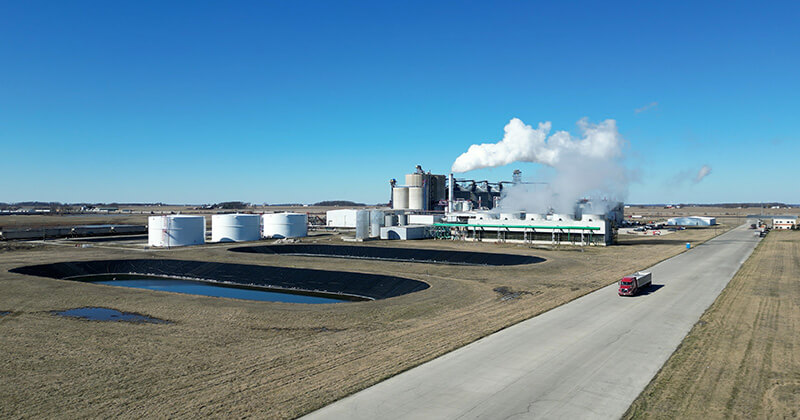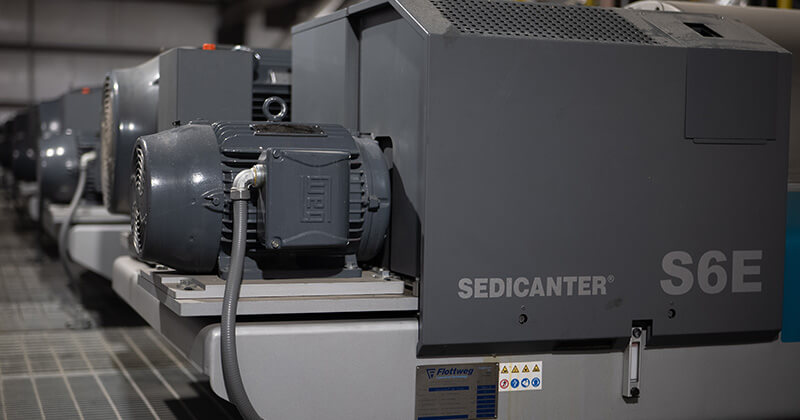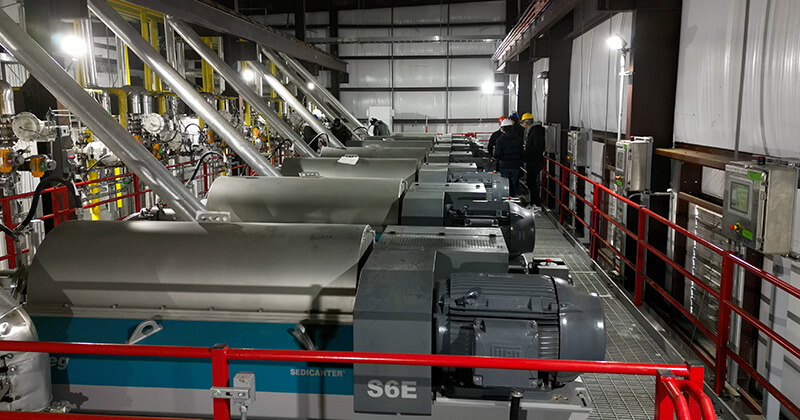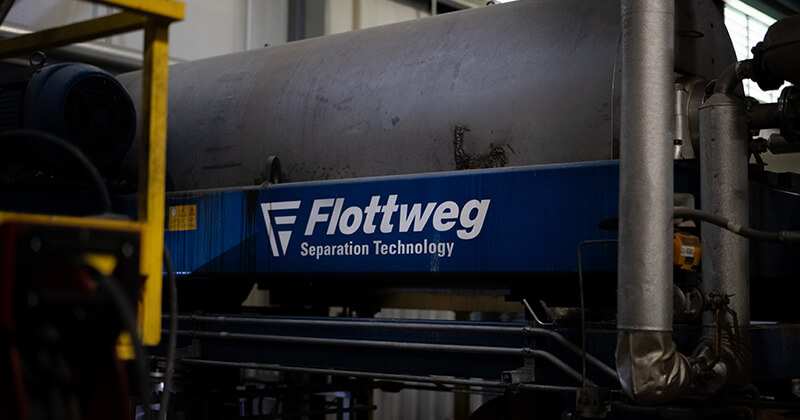2025-07-01
Ethanol Plants Use Advanced Processing Package to Produce High Protein Feeds and Increase Plant Capacity While Lowering CI Scores.
Using ICM’s Advanced Processing Package, several ethanol plants have been upgraded to utilize a new technology that enables the fractionation of a traditional distiller’s grains into two different piles—a high-energy pile and a yeast enriched high-protein pile, Protomax. With a combined ethanol production of 300 million gallons per year, these enhanced ethanol plants consume around 100 million bushels of corn annually. Located in the middle of the corn belt, these plants provide ethanol, CO2, and animal feed throughout the United States.

Advanced Processing Package and Centrifugation
Chuck Gallop, Director of Innovation for ICM, explains that ICM’s approach to this technology has been refined in recent years. ICM offers a range of biofuel industry products and services designed to maximize productivity, diversify revenue, and yield valuable feed products. “We roller mill the corn to control the particle size more accurately, and then it is slurried and liquefied,” Gallop says. “The next step is to remove components of that slurry through a fractionation process called Selective Milling Technology and Fiber Separation Technology. These two technologies combined to separate the solids from the liquids, re-mill the solids in a wet state, and then multiple stages of counter flow washing of those solids to produce a clean fiber product.”
 Chuck Gallop, Director of Innovation for ICM
Chuck Gallop, Director of Innovation for ICMThe solids are separated and dewatered with a rotary press to create a low-protein, low-starch, high-fiber product. The fiber sidesteps the entire ethanol process, freeing up fermentation and distillation capacity and optimizes pump, heat exchanger, and centrifuge efficiencies. After the fiber is removed, high protein, starch rich liquid is processed through fermentation and distillation. The de-fibered beer is processed through optimized decanters.
“We use a Flottweg decanter that's been optimized for high-protein processing and high fat removal,” Gallop says. This process is called FOT (Feed Optimization Technology)—a two-stage process that uses several decanter enhancements to include a proprietary open body scroll to increase the decanter capacity and the cake dryness.
“After processing through FOT, the washed wetcake out of the second-pass decanter is now much higher in protein than traditional wetcake,” Gallop explains. “It's somewhere between 55 and 57% protein on a dry matter basis. The centrate from the first-pass decanters, which would normally go directly to the evaporators, goes through a Sedicanter®, which is Flottweg’s high G-force decanter-style centrifuge. This removes fine suspended solids to include the yeast from the decanter centrate. The yeast cake is then mixed with the decanter cake to make Protomax™. At that point we have a clarified stillage, which goes to evaporation.”
With the use of Sedicanters® in ICM’s TS4™ process, the suspended solids are removed, the evaporators become more efficient, and the total solids can cycle up in the syrup to much higher levels. This produces anywhere from seven to ten concentrations of solids in the syrup.
Traditionally, ethanol plants have made dry distiller’s grains with solubles—a large pile of the most imperfect blend of materials. ICM’s approach is to take the dried distiller’s grains and solubles pile and fractionate it into individual piles or components, making it marketable for specific animals or pets. For example, the fiber and syrup are blended, which is a great, high-energy feed for livestock. The protein is then concentrated, making it perfect for dairy cattle, swine, poultry, aquaculture, and pets. When the distillers corn oil is removed, it is perfect for biodiesel, renewable diesel, sustainable aviation fuel, and for increasing energy content in animal feeds.
In addition, there's a growing segment of renewable fuels—specifically renewable diesel and sustainable aviation fuel. Vegetable oils, specifically distiller’s corn oil, are a low CI feedstock that's perfect for those renewable diesel and sustainable aviation fuels.

Why Separation Equipment is Needed in the FOT Process
In the past 20 to 25 years of the ethanol process, there has been an evolution that includes the enhancement of solid-liquid separation post distillation. “Without this enhancement, we would consume a tremendous amount of energy used to dry the solids and evaporate the water,” Gallop explains. “In fact, if we take a step back and I were to describe the ethanol process in very basic steps, the first step would be to mix grain with water. The second step would be to distill the ethanol from the grain and water. The third step would be to separate the remaining grain from the water. To do this, we use centrifuges.”
ICM uses Flottweg centrifuges to separate the suspended solids from the water. The water at that point goes to the evaporators to be concentrated into condensed distillers solubles or more commonly known as syrup. The solids go to the dryers. “Without that centrifuge step, there would be too many solids in the water for the evaporators and too much water in the solids for the dryers. The centrifugation step is essential to the success of every ethanol plant,” Gallop says.

Conclusion
Since 2005, ICM and Flottweg have developed a growing partnership. It started with installing decanters into the ethanol process. Flottweg decanters were capable of processing twice as much of the of the whole stillage on a per-machine basis than other previously-used centrifuges.
“ICM and Flottweg have continued to collaborate into an exclusive partnership where we developed an oil recovery system utilizing Flottweg’s Tricanter™,” Gallop says. “ICM calls it Base Tricanter System or BTS™. We then developed TS4™, which is the Thin Stillage Solid Separation System using Flottweg’s Sedicanters®, which are a pressurized high G-force decanter. It’s a decanter style centrifuge that performs equally or slightly better than a stack disk centrifuge for stillage clarification. And then most recently, we developed the Feed Optimization Technology or FOT™, which uses the enhanced scroll design in concert with several additional improvements to the Flottweg decanters to increase the throughput and cake dryness of each decanter.”

With the increased throughput, it is possible to split the decanters into two passes. The primary separation step is followed by a re-wetting of the cake solids and then a secondary decanting step. “Without those improvements to the internals of the decanters, this technology would not have been financially plausible,” Gallop explains.
Through innovative and robust plant design, ICM focuses on profitably adding value to local agriculture and feeding the world. “We recognize that the world is starch long and protein short,” Gallop says. “So, the way we can address this is taking those feedstocks that have too much starch and too little protein and concentrate that protein into a feed, going to our livestock, and then that becomes a food source. ICM partners with companies that have the same mindset, and the same drive to enhance humanity. By working together, we are developing technologies and solutions that enhance every one of these plants.
Author
Daniel Lakovic is the Business Development Manager for Flottweg Separation Technology Inc. Daniel holds degrees BS in International Business and an MBA in Finance. He can be reached at dlakovic@flottweg.net.
